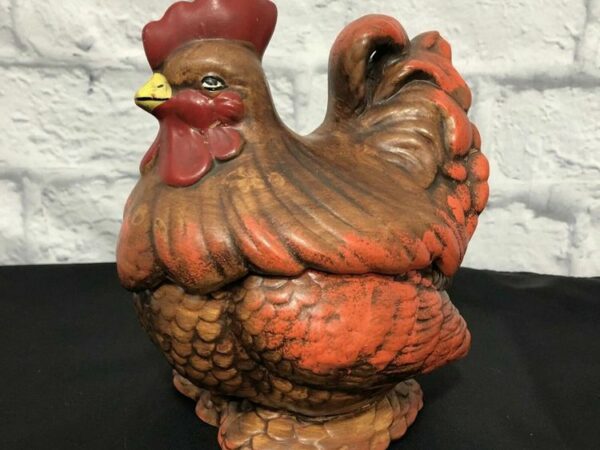As a kid, I used to go stay at my grandparents’ farmhouse almost every summer and spring break. It’s been a long time now since I have been there and I remember only vaguely what it used to look like, but one thing that is completely imprinted on my mind is the weathervane on top of the cottage roof that used to fascinate me a lot.
Back then, I wasn’t familiar with the function of weathervanes. A metal-made rider riding on a metal-made rooster above the direction of arrows madly spinning was something I have never seen before (we lived in a city and barely traveled to ruler areas), so it caught my attention almost instantly.
That was the start of my lifelong attachment to antiques. At this stage of my life, I not only know all about weathervanes, but I am also a huge vintage weathervane collector, along with other objects. And if weathervanes are something that interests you, let me tell you, if you get your hands on the right piece of vintage weathervane, you can basically make a fortune.
In this article, I will let you know all about vintage weathervanes, how to identify them, and how to value them.
Table of Contents
Weathervane: A Historical Overview
A weathervane was once a practical instrument that predicted storms and let you know about the direction of the wind. Now, we have news channels with meteorologists using sophisticated equipment to predict the weather, so weathervanes have just become a piece of vintage folk art.
Reportedly, the first weathervane to exist was in 48 BCE in Athens. It honored the Greek demigod Triton, son of Poseidon who could pause the ocean’s waves. Weathervanes of ancient Greece were mostly bronze images of Greek gods since ancient Greeks believed that weather would stay calm if an image of divine power is representing it.

Archaeological studies also found quadrant-shaped weathervanes attached to Viking ships. Nowadays, most weathervanes represent the image of a rooster. That is because back in the day, a papal bull ordered all churches to place a symbol of a rooster on rooftops because it represented Peter’s denial of Christ which acted as a reminder for the faithful people to attend the church services.
By the 17th century, weathervanes were commonly placed on rooftops of churches, farmhouses, and public places in Europe and England. Producers and distributors started shipping weathervanes to America. American civic buildings and churches started considering weathervanes to be a significant addition to the architecture.
By the 18th century, weathervanes were an integral part of American history and architecture. Farmers and sailors considered weathervanes to be of great significance. In rural areas around the United States, we can still find churches, lighthouses, and farmhouses topped with weathervanes.
American producers did a lot of experimentation with weathervanes in the 18th and 19th centuries. Efforts were made to improve the quality and functionality of weathervanes.
A person who succeeded at that was Thomas Jefferson. He built a roof-mounted weathervane with one shaft going down the room below the roof. That shaft had an indicator on it that showed the direction of the wind, which meant there was no need to go outside and check the weathervane to know about the wind direction anymore.
Now, we find all kinds of weathervanes in all kinds of shapes, sizes, designs, and materials. Some of them are just rusty pieces of metal, others are of great antiquity that vintage collectors would love to have.
Antique Weathervane Identification
If you ever come in possession of an antique weathervane or ever go out to find one, it’s necessary that you know about its identification. Some unscrupulous dealers don’t hesitate to use chemicals and other artificial means to make a contemporary weathervane look like an antique one — that is what we call fake antiques, and we will let you know below how to differentiate between a real antique weathervane and a fake one!
But first, let’s talk about the material.
Material and Design
In the 18th century, when weathervanes were making their way to America, vanes were originally cut by hand and hammered from copper in the shape of favorite barnyard animals, like a rooster, peacock, horse, cow, buffalo, and whatnot, or other popular folk art, mythological, and biblical motifs.
A lot of producers used wood at first to craft these animals but then switched to copper, which was later hammered into molds cast by hand-carved wooden models. Copper was used for its durability and iron and zinc were used to keep the spinning smooth.
The earliest authentic American weathervane was reportedly made by Deacon Shem Drowne. It showed a large copper-made native Indian. It was mounted on the rooftop of the Province House, Boston in 1716. Deacon Shem Drowne was a prolific designer and maker of weathervanes and is best known for his glass-eyed copper grasshopper weathervane that still sits atop Boston’s Faneuil Hall since 1749.
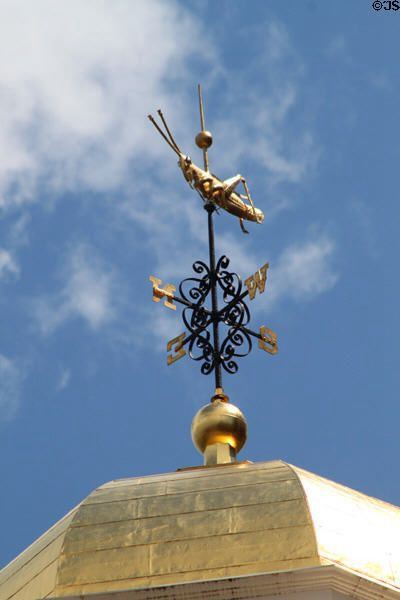
Around the same time, amateur blacksmiths and craftsmen were making early American weathervanes with materials that were available to them, including sheet tin and iron. Copper weathervanes were becoming popular also; they were often created with sections made of iron and/or zinc to ensure a good and smooth spin.
For the finish, artisans used to paint most of the time. Other times, they allowed weathervanes to age with a patina finish, which would eventually look more beautiful and be considered more antique. Some artisans also gold-leafed them to make them look more elegant.
As for the design, the most common designs in weathervanes featured a large variety of barnyard animals, including horses, peacocks, etc. Churches mostly used Christian symbols, such as rooster, angel Gabriel with a trumpet, or a fish. Animal images are the most common and sought-after designs of weathervanes today.
Manufacturers
The earliest manufacturers of weathervanes in America were independent blacksmiths, woodworkers, craftsmen, and sculptors. Reportedly, the first American weathervane was crafted in the 17th century in Boston individually with wood, tin, and copper.
By then, mass production of weathervanes wasn’t far behind. It took only a few more years for big companies to emerge and produce weathervanes on a mass level.
Some companies that made their mark in the production of weathervanes were:
- Harris & Co. (Boston)
- Harris and Sons (Boston)
- L. Jewell & Co. (Waltham)
- Cushing & White Co. (Waltham)
- Howard & Co. (Bridgewater)
- Rochester Iron Works (Rochester)
- Dempster Mill Manufacturing Company (Beatrice)
The last major American weathervane company, Westervelt, was formed in 1883 and went out of operation by 1890. Another notable 19th-century American company was J.W. Fiske from New York City. They produced the iconic three-dimensional trotting stallion weathervane based on the champion trotter Black Hawk in 1875.
These companies manufactured weathervanes by the thousands and they were supplied all around the country. If the weathervane has a mark of any of these manufacturers, there is no doubt left that the weathervane is antique.
Identifying Between Real and Fake Antique Weathervanes
As mentioned above, some makers use artificial elements and chemicals to make a new or contemporary weathervane look like an antique. Some make exact replicas of the vintage weathervanes and sell them off as antiques.
There is only one way you can stay careful not to fall for fake weathervanes: you need to know how to differentiate between the real and the fake. And there is actually a guideline for it.
First and foremost, this might come as a surprise but real antique weathervanes are much finer than the fake ones. Antique weathervanes were rarely painted, they were mostly covered with metal sheets. As a result, they may have gilt borders remaining, which is a basic hint that the weathervane is genuine.
Second, an antique weathervane would have a mellow and rubbed finish, they won’t look shiny. Some weathervanes were also used as targets in shooting practice, so they might even have bullet holes in them, which would give it a backstory and make it more unique and valuable.
That being said, if a weathervane has holes or fissures, a genuine one would have some dust and debris inside. You can give it a shake or pat it to see if that is the case. A fake one wouldn’t sprinkle any debris, which would mean that the holes are deliberately made to make it seem old.
Moreover, antique weathervanes came in a large variety of types, including ones that were mounted on the fence, on the lawn, and on the rooftop. They also came with accessories, such as mounting shafts and roof mounting bases.
A genuine antique weathervane would already be exposed to the weather for over 50 years or even longer. We should expect it to look aged and worn. Paint will only survive if the weathervane was handpainted, otherwise, the natural copper would develop a green patina that cannot be easily replicated.
Antique iron weathervanes should develop crusty red rust if they have been exposed to air for many years. If a weathervane is made of wood, it would be more susceptible to wear and aging and would have a look of driftwood, usually with cracks and rounded edges.
Since natural weathervanes have aging patterns, one side would be more exposed to the elements than the other side, and it can be detected upon careful inspection. Thus, it cannot be replicated.
Another thing to note here is that if you are looking for a clean and crystal weathervane, that’s just not going to happen with antiques. The aging and wear and tear are what make it antique in the first place. And if you try to refinish it, it would lose a good portion of its value.
Keep in mind that none of these guidelines are absolutely certain in determining the age of a weathervane, but they would give you a solid idea in deciding the authenticity of a weathervane. For confirmation, you can always visit an appraiser.
Determining the Antique Weathervanes Value
Antique weathervanes are one of the most appealing, most attractive, and most sought-after items from history. Weathervanes in their unique designs, shapes, and finishings are of great interest to collectors and antique enthusiasts, especially those who are particularly interested in collectibles associated with weather forecasting; such as barometers and thermometers; folk art pieces, and primitive sculptures.
Whether you have come across an old weather vane at your grandparents’ farmhouse or have just caught one on your recent trip to the flea market, it is important to know exactly what kind of value the object possesses.
Knowing the antique weathervanes value would help you decide whether or not you should make a purchase if it would look good and elegant in your antique collection, and how much profit you can make if you decide to sell it.
Although the value of a weathervane can be rightfully determined by an appraiser after accounting for several factors, mainly its value depends on four things: age, condition, patina, and rarity.
Age
Weathervanes made before 1900 were made with detailed molds. Around 1920, the weathervanes started being produced from machines rather than hands, and manufacturers didn’t pay much attention to molds.
The age of a weathervane can be determined by looking at the design, such as feathers on a rooster-imaged weathervane or a head or tail on a horse-imaged weathervane.
Detailed and accurate shapes would mean that the weathervane was made with mold, while lumpy and formless shapes would hint towards the production of later years.
Patina and Condition
Patina is a thin layer that forms on the surface of materials like copper, bronze, brass, and other similar metals and metal alloys because of age and exposure. Patina is probably the most important thing to consider in order to determine the antique weathervanes value.
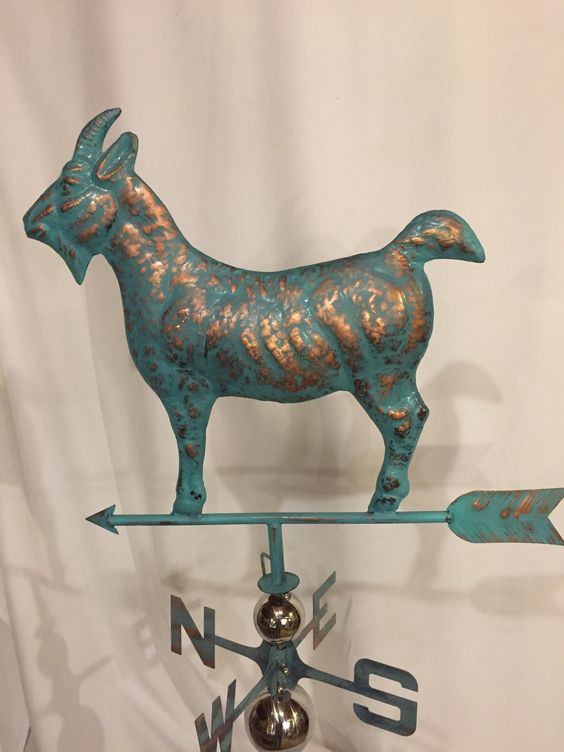
The antique market of the current times values original gold leaf the most, but gold leaf finish is rare. When the original gold leaf is exposed to the elements of weather for decades, it wears off and reveals the brown copper from underneath. The surface of the copper eventually turns green. The longer it stays exposed, the more beautiful the patina will look.
Surface with patina is extremely desirable in antique markets, and it is extremely hard to replicate artificially. If you find yourself in a pickle over a real or fake patina on a weathervane, you can ask for help from an educated collector because they study weathervanes and patinas very carefully.
Collectors know that gold leaf can be applied today in more or less the same way that it was applied when the weathervanes were originally made. Therefore, they look for uniformity on the surface. If the surface is original, traces of gold will remain underneath and towards the rear of the piece. That is because these parts are least exposed to the elements.
If all the signs hint towards the originality of the weathervane, it can be sold for thousands of dollars in the collectors’ market.
Rarity
If we are talking about value, the most expensive weathervanes are the ones that are most rare. However, rarity, age, and condition go hand in hand. Manufacturers’ mark doesn’t really fit the criteria of determining the value of a weathervane, unlike other antique items.
If a particular weathervane is something that you have literally never seen before but is not in “acceptably antique” condition, you might not get the top dollar for it. On the other hand, if the weather vane is visibly as old as it is rare, congrats, you are sitting on a jackpot!
Similarly, the rarer it is, the more value it would have. A weathervane made after 1920 is considered more contemporary than an antique, but a piece made in the 19th century would hold much more value as an antique. Considering the pattern, weathervanes made in the 17th and 18th centuries would be considered the true fortune makers, if you can even find them.
Estimated Value of Antique Weathervanes
Antique weathervanes are sold anywhere between a hundred dollars to several thousand. And the price depends on several factors.
In 2011, an auction sold a rare 1910 touring car weathervane for $941,000.
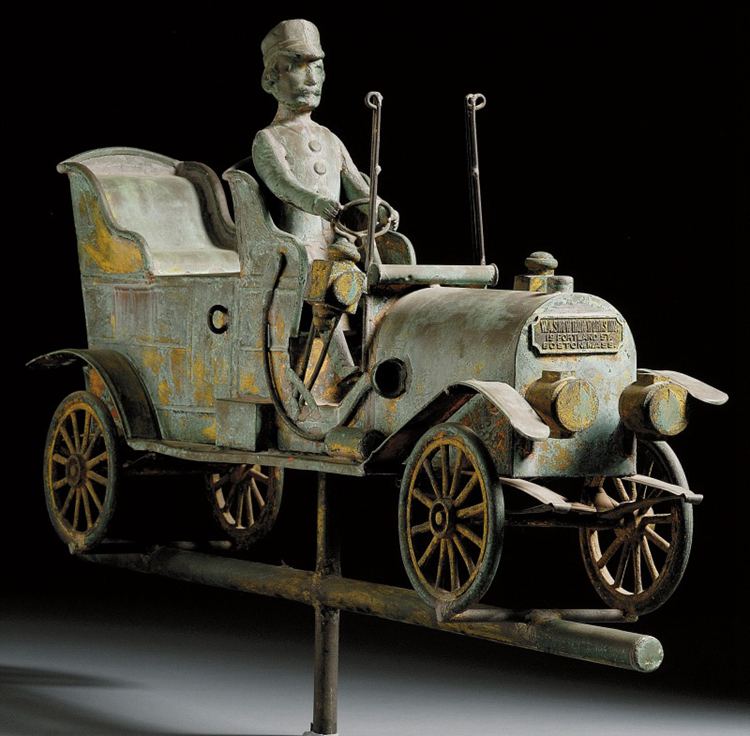
However, the most famous antique weathervane, JR Mott Ironworks’ molded and gilded copper Indian Chief, was sold in 2006 at Sotheby’s auction for $5.84 million.
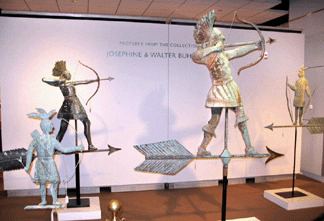
Now get this: antique weathervanes are being sold on Etsy and eBay for around $1,000 to $5,000. However, be careful when you are buying an antique weathervane – most buyers today are selling fake antiques.
Final Thoughts
Antique weathervanes are one of the most appealing items in history. The vintage and collectors’ market is filled with collectors and enthusiasts looking for an antique weathervane to trade further or add to their collection.
Due to the popularity of weathervanes as valuable antiques, counterfeit antiques are emerging every day. To make sure you do not end up buying a fake thing, I let you know about the antique weathervane identification, the differentiation between fake and real ones, and the factors to determine the antique weathervanes value.
Still, the best recommendation I can offer you is to get in touch with a professional appraiser before making a purchase if you are not confident with your knowledge.
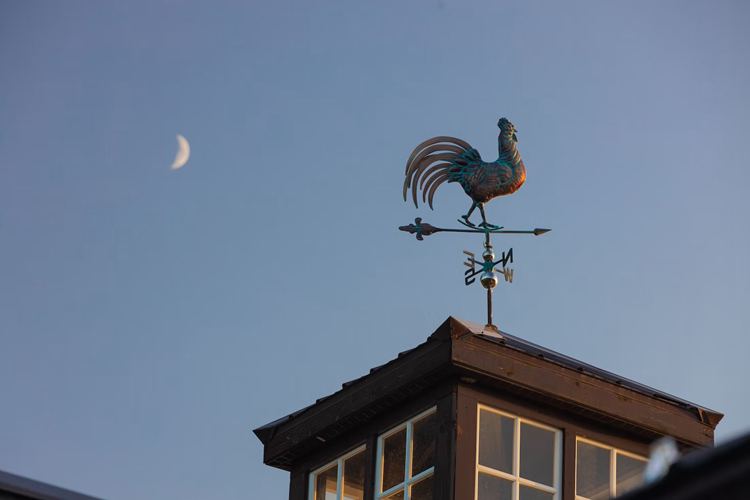
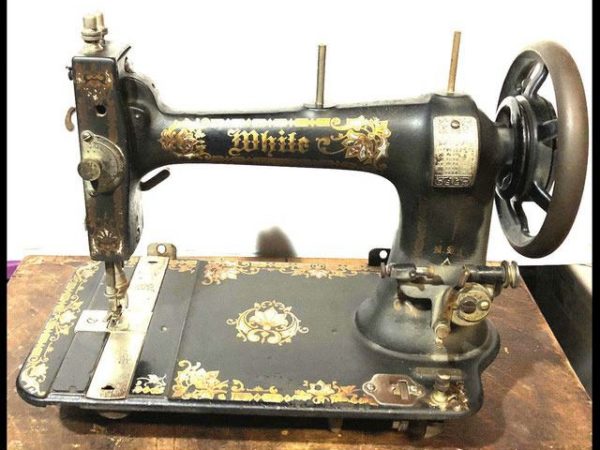

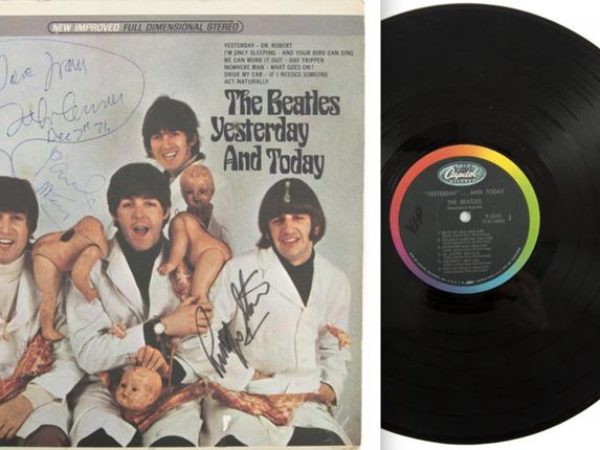

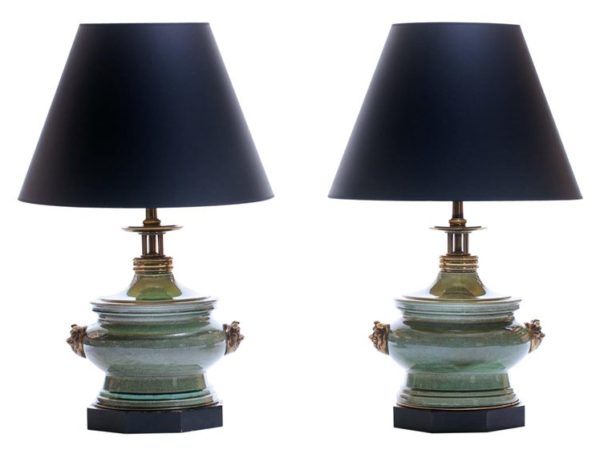
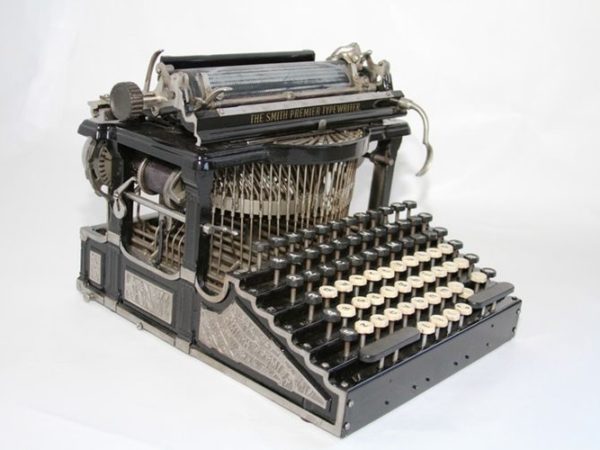
![Vintage Schwinn Bikes: [Types, Identification, and Values]](https://www.txantiquemall.com/wp-content/uploads/2022/05/5.-Schwinn-1967-Ramshorn-Fastback-Stingray-Sky-Blue-vtg-600x450.jpg)
